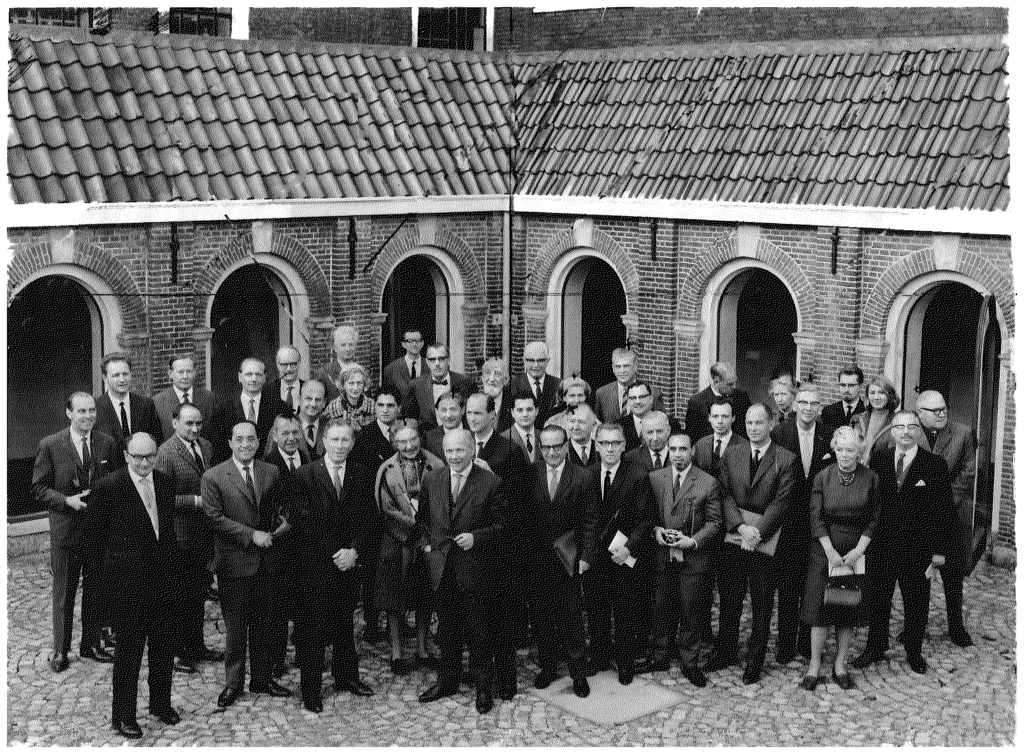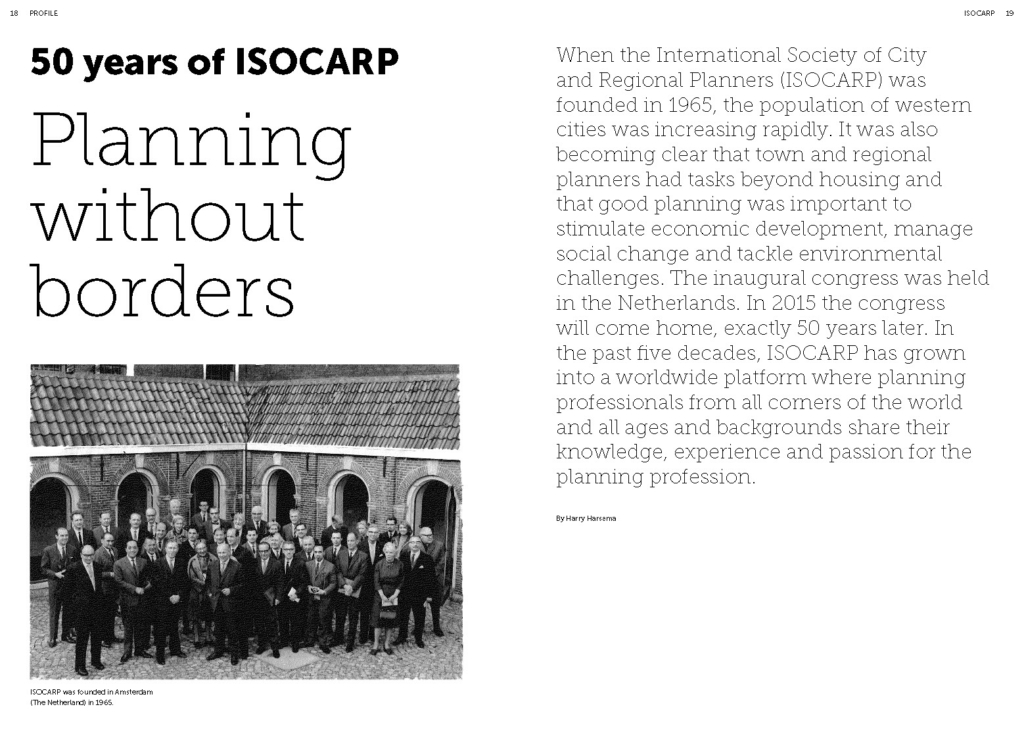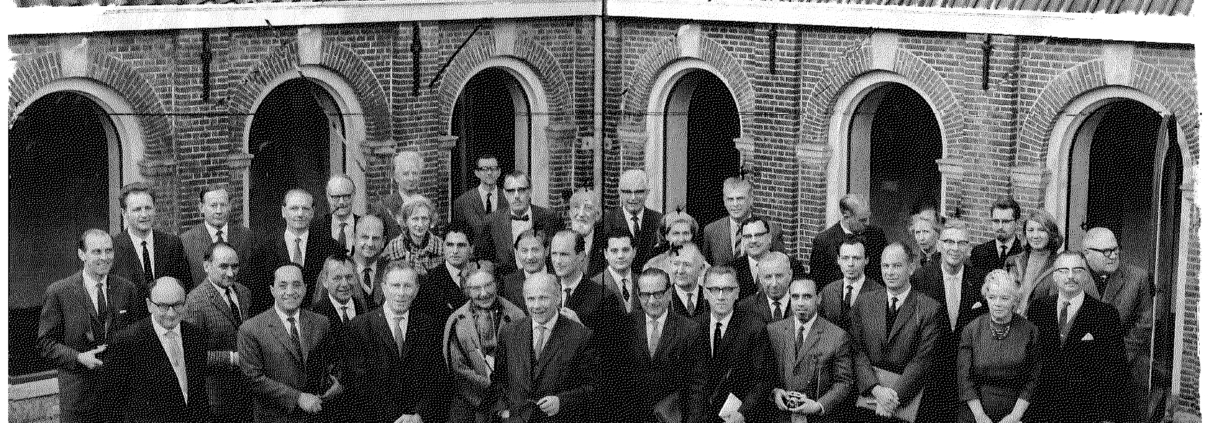Interview ’50 jaar ISOCARP, Planning without Borders’
Eind 2014 ben ik geïnterviewd door Scape Magazine over aanstaande jubileum van ISOCARP, The International Society of City and Regional Planners. In 2015 zou ISOCARP haar 50 jarig bestaan vieren met een groots en meeslepend congres in Rotterdam onder de ronkende titel ‘Cities Can Save The World – Let’s Reinvent Planning’. Dit artikel beschrijft het verleden, heden en de gedroomde toekomst van de in 1965 in Amsterdam en door prof. Sam van Embden opgerichte Internationale Vereniging van Stedenbouwkundigen. Tussen 2011 en 2021 was ik als bestuurslid en 16e voorzitter na Sam van Embden nauw bij ISOCARP betrokken.
When ISOCARP was founded in 1965, population of western cities increased rapidly. It became clear that town and regional planners had tasks beyond housing and that good planning was important to stimulate economic development, to manage social change and to tackle environmental challenges. The inaugural congress was held in the Netherlands. In 2015 the congress will come home, exactly 50 years later. In the past five decades, ISOCARP has grown into a worldwide platform where planning professionals form all corners of the world and from all ages and backgrounds share their knowledge, experience and passion for the planning profession.
It is interesting to see that the congresses of the first ten ISOCARP congresses were quests for what urban and regional planning in the second half of the twentieth century was all about, how it related to cultural heritage, transport planning and economic planning and how planning education should be organised. In his State of the Profession in 1969, Sam van Embden, founder and first president of ISOCARP from 1965-1975, sketched a paradox that, what he mentioned, raised a warning voice in his conscience. ‘I have pointed all the time at gaps in our planning system, gaps to be filled. I have pointed out the necessity to improve and complete that system, to introduce corrections and add extensions. However, it might be asked (though in reality we have long known the answer) whether the prevailing uncomfortable feeling about planning-results among the general public really originated in the first place from the quality of the plans, or whether there are much deeper roots for this general discussion. Is it not so that planning itself, omnipresent, inescapable, is resented as an always farther increasing restriction and narrowing of freedom, as a regimentation of life, as the end of all adventure? And would not the impact of this experience on the mind of men be much stronger than the somewhat poor qualities of their daily environments?’

Foto van de oprichters van ISOCARP op de binnenplaats van de Academie van Bouwkunst Amsterdam in 1965. Met onder andere prof. Sam van Embden en Cor van Eesteren en toenmalig wethouder van Amsterdam Joop den Uyl.
‘Here we are on the horns of a dilemma,’ van Embden continued, ‘for there is no doubt whatever that we simply cannot stop, or even slow down, planning and organizing without immediately endangering the existence of the three, soon six billion inhabitants of this planet. But the more these planning-systems will extend and tend to organise their lives, the more each separate individual will feel exasperated and the stronger it will oppose the restrictions laid upon it in the name of the Community. The only answer I would know to this dilemma for the moment refers to a renewal of our mental disposition. In the first place it concerns those who have to accept planning, but also (and from our point of view this is the most important side) of those who are actively involved in the planning-work. For all of them the main objective should be to find out how to plan freedom. In my opinion this means: to learn how to plan as if we were not planning. This is more a question of mental attitude than of method, more of wisdom than of knowledge. To this, just as to every other really fundamental problem, there is no real and lasting answer. Each new generation will meet it under another appearance, each generation will have to find its own solution. We should search for ours.’ Today, these words of van Embden are as topical as 45 years ago.
The Urban Millennium
ISOCARP was founded to study and to discuss urbanisation that was progressing irresistibly in the 1960’s. Today, more than 50% of the world population is living in cities and this percentage is increasing. ‘The motto of ISOCARP, “Knowledge for Better Cities”, describes exactly where we as a society of planning professionals stand for.’ says Milica Bajic-Brkovic, professor of urban planning and design at the University of Belgrade and now the 15th President of ISOCARP. ‘The active involvement of our members in the preparation and participation of our congress, publications and workshops is our greatest strength.’ Milica Bajic-Brkovic refers to the annual congresses in the past five years (2009-2013) in Porto, Nairobi, Wuhan, Perm and Brisbane. They all tackled topics like low carbon cities, planning in a hyper dynamic age and changing frontiers of planning, that were ahead of the mainstream discussions in the planning profession. Parallel to our congresses ISOCARP has published a wide variety of essays and articles on these topics in their annual Review. Milica Bajic-Brkovic: ‘The ISOCARP congresses have brought our members in contact with many other planning professionals and organisations that find planning important. One of our highlights was our congress on sustainable development in the developing world in Nairobi with over a thousand participants that partially took place in the headquarters of UN-HABITAT. Since that congress we have close working relation with UN-HABITAT.’
Jeffrey Featherstone, director and professor at the Center for Sustainable Communities, Temple University in Philadelphia, was the General Rapporteur of the ISOCARP congress in Brisbane in 2013. His conclusion: contemporary urbanisation is totally different from past city development. Featherstone: ‘Above all else we have now entered the urban millennium in which cities and city planning are critical to the majority of the world’s now urbanised population. In this sense we have entered a “new world” that maybe can be compared with the first years of ISOCARP. The scale and speed of change challenge the traditional plans of governments in rapidly changing urban regions. The drivers of urbanisation may still be what they have always been – agglomeration advantages, economic opportunity, more exciting lifestyles, and intensified interactions – but their impacts are now multiplied many times over.’ The congress team and the authors of almost 200 papers have questioned themselves what effective planning practice is at the global frontiers, whether it is planning for the local community, or mature metro, or mega-city, or vast urbanising region. Featherstone: ‘We learned about the critical importance for cities to become more resilient to change and uncertainty. And we became aware of the necessity to bridge theory and practice by implementing experimental learning and involving multiple stakeholders. This is important because we need to define or redefine the planning discipline, especially for the education of the next generation of planners.’
Urban Transformations
The urban transformations and the relationship between cities and water is the main theme of the next urban and regional planning congress of ISOCARP that will take place 23-26 September 2014 in Gdynia, Poland. ‘Water is everywhere and water related issues are significant in planning of any type and scale’, explains Amos Brandeis, director of one of the leading offices urban and regional planning in Israel and General Rapporteur of the congress in Gdynia. ‘Nearly all cities around the world were built along waterways, or along a coast of an ocean, sea or lake. You would think that through history cities and city planners are very well aware of the delicate relationship between urban settlements and water.’ Brandeis comes to a different conclusion: ‘We can read almost daily in our newspapers about severe drought and flooding due to human interventions, climate change and lack of adequate planning. Water related issues like drinking water, food, safety, trade, nomadic lifestyle and other issues may have been one of the most important aspects that shaped planning, societies, cultures, and the environment.’ He reminds us that over time, in different continents, countries, climates, civilizations and cultures, the role of water in planning has changed. Brandeis: ‘Today, water related issues, and their role in urban and regional planning set a wide array of different major challenges, from providing cities in arid areas access to drinking water to protect cities in river deltas from flooding. These challenges need to be addressed in almost any plan or project worldwide, and influences and enhances “Urban Transformations” in many ways.’
The theme “Urban Transformations – Cities and Water” is a topical theme that reflects one of the current priorities in planning in Poland. In the past few years, cities in Poland have suffered from flooding. Unusual heavy and continuous rainfall in Central Europe combined with the extension and intensification of urban areas showed that the catchment areas of the rivers were in need of extension as well. ‘Some effected cities, like Poznan, reacted immediately and hired leading experts from the Netherlands who advised to reopen and reuse former riverbeds for water catchment’ says Slawomir Ledwon, adjunct professor at the Department of Urban Design and Regional Planning, Gdansk University of Technology and Vice President Congresses and Events of ISOCARP. ‘Apart from that, the issues of new development and public spaces near water are also much debated. For example Gdynia – the congress city – is redeveloping its port areas for new uses. The theme of the conference opens the opportunity to touch all aspects of urbanity and the inherent relationships between the urban planning and water issues, from all angles, in all disciplines, and various scales. The broad picture will hopefully provide every one of us with awareness, knowledge, knowhow, tools, sensitivity, and passion to face these challenges in our daily professional life and in the training of the present and upcoming planners.’

Cities can save the world
In 2014 and 2015 ISOCARP celebrates its 50th congress in Poland and its 50th anniversary in the Netherlands with international seminars and workshops, publications and an invitation to the planners of the world to reinvent planning. ‘Urbanization used to be seen as a threat. Today it’s increasingly recognised as a positive force,’ says Andries Geerse, principal of We Love the City based in Rotterdam and one of the initiators of the 2015 congress. ‘The innovative and energetic character of urban life means that cities act as the engines of national economies, driving wealth creation, social development and employment. You can say that cities are of vital importance and can save the world. The urban environment acts as the primary locus for industrial and technological progress, entrepreneurship and creativity.’ Geerse focuses on the perspective of sustainability and states that urban areas do more with less as compared with suburban or rural areas. ‘Large cities tend to be the greenest places, because people in denser habitats typically have smaller energy footprints, require less infrastructure and consume fewer resources per capita. Despite these advantages, urbanization presents challenges that differ throughout the world. The challenge for us, planners, is to use the innovative power of cities to create new forms of sustainable and inclusive growth that saves our economy.’
Geerse is not unaware of the critical view nowadays of planning in many western countries. But he points at the many voices that are calling for a “planning” approach – the practitioners, who are looking for solutions to complex problems with both long and short-term dimensions. Geerse: ‘The mayors of Paris and Amsterdam have developed a partnership aimed at exchanging ideas on issues ranging from regional planning to cultural heritage to airport planning. That mayors of major cities actively show interest in planning opens a window of opportunities. In China, Africa and many other emerging countries, leaders from a variety of sectors are increasingly asking planners for solutions to urban problems, from the global level to the local.’ And Geerse brings in another important player in the field of planning: the World Bank that for decades favoured a sectorial approach over an integrated ‘planning’ approach. Geerse: ‘Recently the organisation made an about-face, turning to planners to implement its ambitious new urban strategy that focuses on harnessing the potential of urbanisation to deliver equitable and inclusive growth and poverty reduction.’
Reinvent Planning
‘Planning is no longer confined to a closed category of professionals’ says Albert van Hattum, chair of the Netherlands local committee that organises the congress that celebrates the 50th anniversary of ISOCARP in the Netherlands in 2015. He promises that this event will be different from any other event organised by ISOCARP. Van Hattum: ‘Planning is being redefined as anyone who is committed to the city and to the key components of a planning approach: integration, a connection between the short and long term and a drive to overcome the conflicts between different interests. Those who have understood this well will make up the next generation of city builders and will develop the solutions for our urban challenges.’ For the 2015 congress ISOCARP already has the commitment and cooperation of about ten cities and regions in the Netherlands and in regions in neighbouring countries. These cities and regions will all host pre-events in which local issues and challenges will be discussed. Van Hattum: ‘The diversity of participating cities from Netherlands, Belgium and Nordrhein-Westfalen demonstrate the wide range of situations. Even within a growing economic agglomeration, there are different speeds of growth, including some shrinking regions. This inspires participants to identify the specific situation and strength of their cities, wherever they are in the world.’
‘In order to reinvent planning we need actively to involve the next generation of planners, if they are master students, doctorate students or in the first years of their career, that doesn’t matter,’ explains Piotr Lorens, professor and head of the Department of Urban Design and Regional Planning, Gdansk University of Technology and Vice President Young Planning Professionals of ISOCARP. ‘What we need to address is that theories and practices of planning change every decade or so and that there are big differences between countries and regions. The sooner they get in contact with students and young and more experienced planning professionals in other countries, the better. We organise the international young planning professionals workshops once or twice a year and the involvement of young planning professionals with paper presentations on our annual congresses are like wide open doors to the planning profession. It makes them smarter, they acquire internships and some even get jobs because of their active involvement in our activities. All we have to do, as ISOCARP, is to establish a worldwide network of ambitious and talented young planners, stimulate them to learn from the mistakes of previous generations of planners and to think independently like we did when we came into the profession ourselves.’
Past, present and future
With at present a little more than 50 members, China is becoming an increasing factor in ISOCARP. In past years the megacities Dalian and Wuhan hosted the ISOCARP congresses in 2008 and 2011. Additionally, Wuhan, Shantou and Nanjing invited Urban Planning Advisory Teams from ISOCARP for strategic advice in large-scale urban planning projects. ‘Chinese cities are competing with each other and are actively looking for inspiring examples and best planning practices in cities in other continents,’ says Shi Nan, secretary general of the Urban Planning Society of China and Vice President Publications of ISOCARP. ‘ISOCARP brings us in direct and personal contact with planning officials, universities, consultants and urban design studios in cities all over the world. The history, the status and the high profile of ISOCARP, combined with the personal relations with individual members is important and opens doors in China that otherwise remain shut.’ On a regular basis, urban planning institutes of Chinese cities invite foreign experts to help them in or to access their city planning and urban design. Shi Nan: ‘Especially expertise on themes like water management, tourism, cultural heritage and integral planning is in demand. On the other hand we notice that Chinese planners – our society has about 20.000 members – are increasingly active outside China. They export our experiences with large scale and fast urban development in other parts of Asia, Africa and Eastern Europe.’
‘I noticed in the recent UPAT workshops that Chinese cities and regions are growing so incredibly fast that Chinese planners have difficulties in being and working well ahead of current developments,’ adds Martin Dubbeling, urban planner and designer at Connecting Cities and Vice President Urban Planning Advisory Teams of ISOCARP. He lead several advisory teams and one that with a team of senior experts of the Urban Planning Society of China last year jointly helped and advised the Nanjing Urban Planning Bureau with their assignment from the Chinese central government to plan and develop Jiangbei New District. This district is destined to be one of the motors of economic development in Jiangsu Province in the next decade. For this area of roughly 2000 km2 and situated north of the Yangtze River, strategic plans are in the making for new industries, new CBD’s, university campuses, residential areas for 4 million people and two new airports. Dubbeling: ‘During our site visits we learned that the new area was situated in the floodplains of the Yangtze River, that there already were 1,5 million people living there and that the region was scattered with heavy and polluting industries. We also learned that in the planning area metro lines were planned and under construction by the Nanjing Transport Planning Authority without direct involvement of the Nanjing Urban Planning Bureau. And finally we learned that our Chinese colleagues had difficulties in providing a series of maps of the region that show past developments, the present situation and short and long-term developments. For our Chinese colleagues it seemed that past, present and future are not to be separated’.
Planning principles
‘Instead of connecting the present and new airports with the networks of metro lines and the national high-speed railway network,’ Martin Dubbeling continues, ‘the most important question that really bothered our colleagues in Nanjing was “do we need 15 bridges and tunnels to connect the new area with Nanjing or are 12 enough?” After long discussions and a hands-on workshop in which we analysed the water and the transport system of the planning area, we succeeded in getting their attention and focus back on basic planning issues that are of the essence and that really matter.’ As a result of the work of the two teams there was an agreement on eight basic planning principles for the future development of the Jiangbei New District. Dubbeling: ‘We presented these joint ISOCARP & UPSC planning principles in a special session to the Nanjing City Council. The principles vary from developing a spatial vision for the Jiangbei New District on a regional scale, to enhance transit oriented development and to develop blue-green and blue-red strategies on every possible scale. We also made clear that these principles requires on-going investments in training and capacity building, in the cooperation with other organisations and other planning institutes and in the communication with present and future inhabitants.’ Dubbeling is glad that his colleagues from Nanjing intend to be active participants in the 2014 ISOCARP congress in Poland on cities and water. ‘We are happy to help them, in the spirit of Sam van Emden, to find their own solution for their challenges in planning the Jiangbei New District.’

The article ’50 years of ISOCARP, Planning without borders’ by editor in chief Harry Harsema is published in Scape Magazine #14, August 2014, page 18-27.
Download hier het artikel ’50 years of ISOCARP, Planning without borders’: https://martindubbeling.nl/wp-content/uploads/2014/11/DOWNLOAD-613_Scape-Magazine_50-years-of-ISOCARP_Planning-without-borders.pdf




